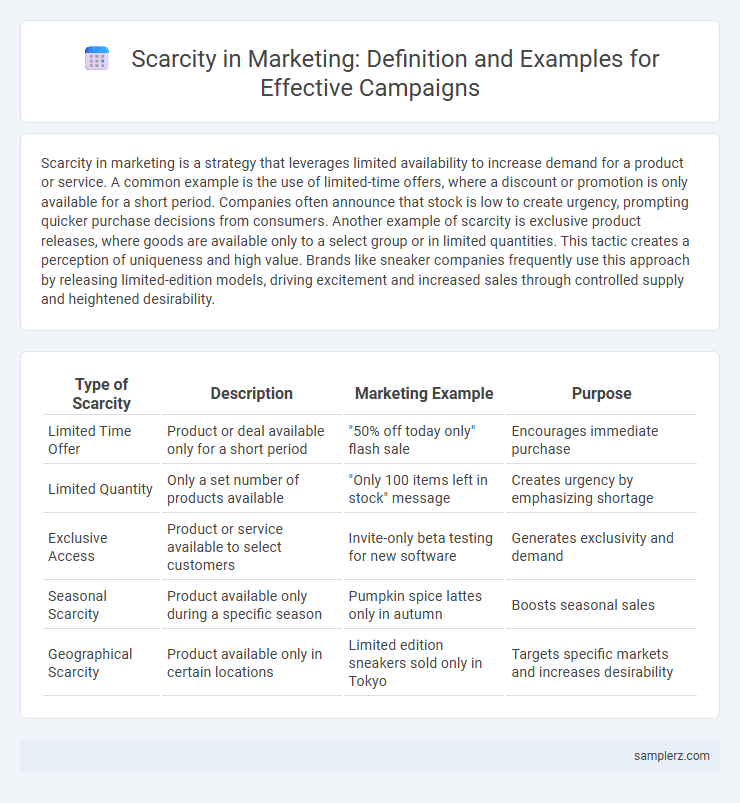Scarcity in marketing is a strategy that leverages limited availability to increase demand for a product or service. A common example is the use of limited-time offers, where a discount or promotion is only available for a short period. Companies often announce that stock is low to create urgency, prompting quicker purchase decisions from consumers. Another example of scarcity is exclusive product releases, where goods are available only to a select group or in limited quantities. This tactic creates a perception of uniqueness and high value. Brands like sneaker companies frequently use this approach by releasing limited-edition models, driving excitement and increased sales through controlled supply and heightened desirability.
Table of Comparison
| Type of Scarcity | Description | Marketing Example | Purpose |
|---|---|---|---|
| Limited Time Offer | Product or deal available only for a short period | "50% off today only" flash sale | Encourages immediate purchase |
| Limited Quantity | Only a set number of products available | "Only 100 items left in stock" message | Creates urgency by emphasizing shortage |
| Exclusive Access | Product or service available to select customers | Invite-only beta testing for new software | Generates exclusivity and demand |
| Seasonal Scarcity | Product available only during a specific season | Pumpkin spice lattes only in autumn | Boosts seasonal sales |
| Geographical Scarcity | Product available only in certain locations | Limited edition sneakers sold only in Tokyo | Targets specific markets and increases desirability |
Real-Time Countdown Timers: Creating Urgency
Real-time countdown timers in marketing campaigns significantly boost conversion rates by creating a sense of urgency and limited availability. These timers visually communicate the dwindling time customers have to claim special offers or discounts, leveraging the psychological principle of scarcity. Ecommerce platforms using real-time countdowns report up to a 30% increase in purchase frequency during promotional periods.
Limited Edition Products: Driving Exclusive Demand
Limited edition products create a sense of scarcity by offering unique items available for a short time or in limited quantities, enhancing customer desire and urgency to purchase. Brands like Nike's limited sneaker releases or luxury watches tied to exclusive events capitalize on this strategy to boost perceived value and exclusivity. This scarcity tactic not only drives immediate sales but also strengthens brand loyalty by appealing to consumers' fear of missing out (FOMO).
Seasonal Offers: Harnessing Short-Lived Opportunities
Seasonal offers create urgency by limiting availability to specific time frames, driving consumers to act quickly before the deal expires. Retailers use holiday sales, summer promotions, and year-end discounts to capitalize on seasonal demand fluctuations and boost short-term revenue. Limited-time seasonal campaigns increase conversion rates by leveraging fear of missing out (FOMO) and enhancing perceived value.
Low Stock Alerts: Motivating Quick Decisions
Low stock alerts create a sense of urgency by informing customers that product availability is limited, driving faster purchase decisions. This scarcity tactic leverages fear of missing out (FOMO) to increase conversion rates and reduce cart abandonment. E-commerce platforms reporting real-time inventory levels often see improved sales performance by motivating quick actions.
Flash Sales: Capitalizing on Impulse Buying
Flash sales create a sense of urgency by offering limited-time discounts, prompting consumers to make immediate purchase decisions to avoid missing out. These short-lived promotions leverage scarcity by restricting availability, boosting impulse buying and increasing conversion rates. Brands often see a significant spike in sales during flash sales due to the psychological pressure consumers feel from the perceived scarcity of the deal.
Membership Caps: Boosting Premium Sign-ups
Membership caps create a sense of exclusivity that drives urgency among potential customers, encouraging faster sign-ups for premium plans. Limited availability of premium memberships signals high value and rarity, compelling prospects to act quickly to avoid missing out. This scarcity tactic effectively increases conversion rates by leveraging the fear of losing access to exclusive benefits.
Early Bird Discounts: Rewarding Swift Action
Early Bird Discounts create urgency by offering limited-time price reductions to customers who make purchases quickly. This scarcity tactic leverages the fear of missing out, encouraging faster decision-making and boosting early sales. Companies often set strict deadlines for these discounts to amplify their effectiveness and maximize conversion rates.
“Only X Left in Stock” Notifications
"Only X Left in Stock" notifications create urgency by highlighting limited product availability, encouraging quicker purchasing decisions. This scarcity marketing tactic leverages psychological triggers like fear of missing out (FOMO) to boost conversion rates. Retailers report that products with such notifications often see a significant increase in sales velocity and customer engagement.
Limited-Time Freebies: Adding Value with Restrictions
Limited-time freebies in marketing create urgency by offering customers exclusive access to products or services at no cost for a short period, boosting engagement and driving immediate action. This scarcity tactic leverages fear of missing out (FOMO) to increase conversion rates and enhance perceived value. Brands utilize limited-time free trials, complimentary samples, or bonus gifts to stimulate demand and foster customer loyalty.
Exclusive Access Events: Encouraging Elite Participation
Exclusive access events leverage scarcity by limiting attendance to a select group of elite participants, enhancing perceived value and driving demand. Brands create urgency through invitation-only previews, VIP product launches, or members-only webinars, fostering a sense of privilege and exclusivity. This strategy not only boosts brand prestige but also increases customer loyalty and engagement by making access feel rare and coveted.

example of scarcity in marketing Infographic
 samplerz.com
samplerz.com